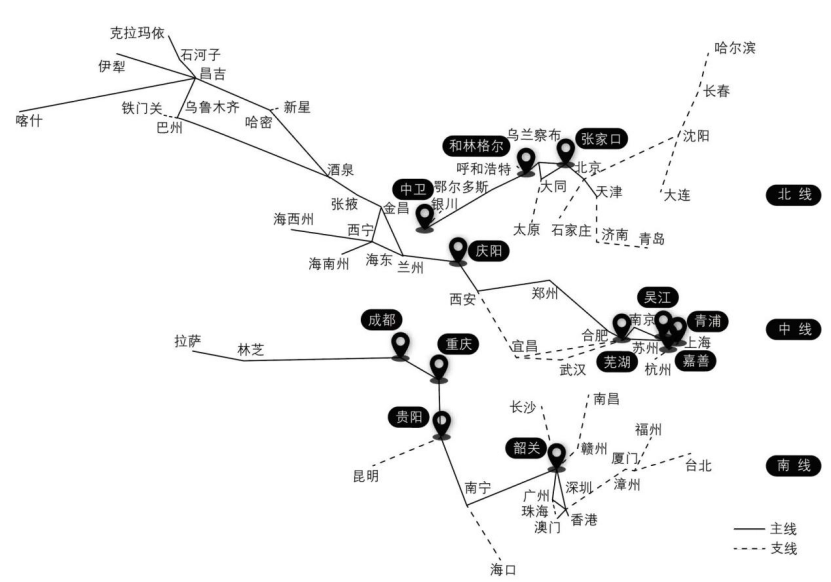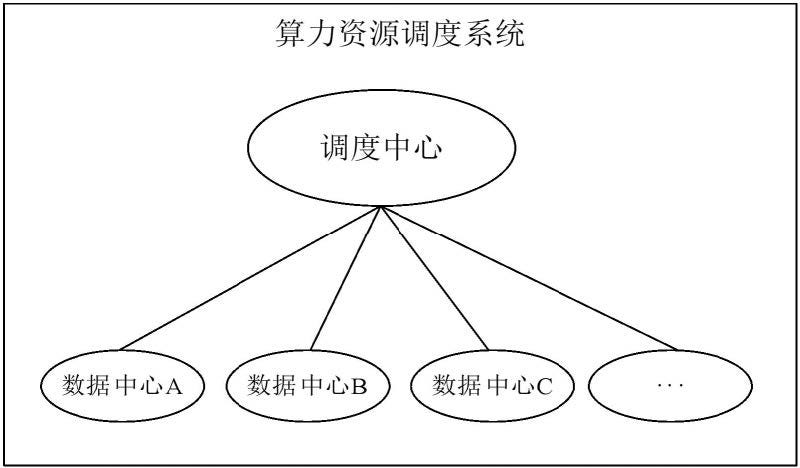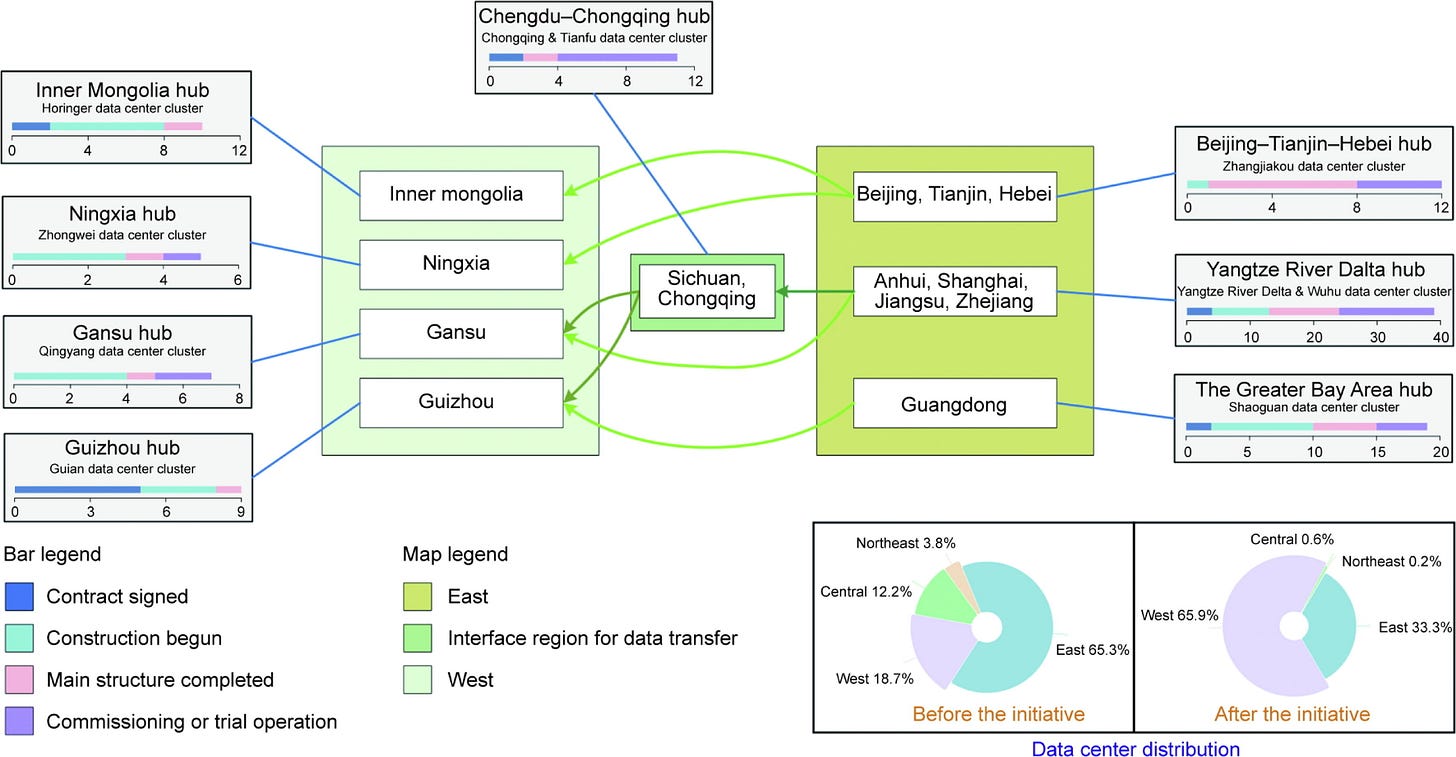China is trying to create a national network of cloud computing centers
With implications for AI development and the future of its cloud ecosystem

I’ve written before about the Eastern Data Western Compute 东数西算 project, China’s effort to boost its’ “computing power” by constructing new data centers in the country’s West. So far, I’ve mostly focused on efforts to build out new clusters of data centers in western locations including: Zhangjiakou (Hebei), Hohhot (Inner Mongolia), Gui’an New Area (Guizhou), and Qingyang (Gansu). But the EDWC project is, at least in theory, more than the sum of its parts.
The vision of the EDWC is not only about building new “nodes” of data centers, it is also about creating a “national network of computing”, 全国算力一张网 quanguo suanli yizhang wang so that computing power can be shifted between data centers depending on fluctuations in computing demand and supply in different regions, not unlike the way interconnected or smart power grids can move electricity around the grid depending on where demand is greatest. One of the premises of the EDWC is that data centers, which consume large amounts of energy, should be located in areas with ample renewable energy supply and cheaper land and energy than in the populated east coast. Networking computing resources across the country can make better use of energy in the West without having to transmit electricity from West to East.
So far, the “computing network” aspect of the EDWC plan has received very little attention even though it may be one of the more significant aspects of the plan. I’ve not written about it before because details are hard to come by, and the implementation is not clear, even though some of the conceptual and technical ideas have been laid out in research papers by China Telecom, Huawei, and the CAICT—an influential think tank of China’s Ministry of Information and Internet Technology (MIIT). But I will try to detail here what we know so far, and what has and is being done on this:
“The EDWC project is not only about building new “nodes” of data centers, it is also about creating a “national network of computing”, 全国算力一张网 quanguo suanli yizhang wang so that computing power can be shifted between data centers depending on fluctuations in computing demand”
A National Network of Computing Centers
In a televised interview in 2022, Yu Xiaohui 余晓晖 the President of the influential think tank CAICT1, which has played a leading role in developing the EDWC plan, notes that “other countries are doing similar things [to the EDWC] but only within one cloud company, but this is an advantage of China, we are doing a systematic layout.”2 In other words, what he alludes to is the fact that the EDWC project is a state-led effort to coordinate the data center infrastructure of the entire country, which requires going beyond simply encouraging cloud/telecom providers to invest in their own new cloud computing centers. It also means creating a unified national computing network that would allow for a more dynamic allocation of computing demand across the country.
But to do this requires creating a system that can allocate demand from computing centers of different providers. From a business and data privacy standpoint this seems difficult to do. However, China’s three state-owned telecom operators are the ones playing a significant role in building out the EDWC project. In a 2023 research article, engineers from China Telecom outline the basic idea of what they term “computing power gateway” 算力网关:
“The computing power network is a new network technology that distributes computing, storage, algorithm and other resource information of computing power nodes through the network, and combines network information and user needs to provide the best distribution, association, transaction and allocation of computing, storage, network and other resources, thereby realizing the optimal configuration and use of various resources.”
“As the core network element device in the computing power network, the computing power gateway is based on computing power measurement and computing power identification, and transmits and publishes related computing power strategies and data forwarding through core functions such as computing power routing and computing power perception. It is the basis for realizing the integrated scheduling of computing power network”3
Dispatching Centers 调度中心
In various documents and news announcements there have been reference to 调度中心 or “adjustment centers” in each of the data center nodes, which are supposed to function as traffic centers for nationwide computing resources, balancing supply (western data centers) and demand (eastern applications). Such “adjustment centers” allow computing tasks to be dynamically allocated to different data centers, such as allocating workloads between 8 national computing hubs and 10 data center clusters, optimizing latency, and improving energy efficiency by redirecting “non-urgent” data tasks to western renewable-powered hubs during off-peak hours. A patent application filed in 2023 by a Beijing-based company CASDAO (算力互联) outlines the basic requirements for such a “data center scheduling center”, using AI to assign compute requests to different data centers based on matching the requirements (i.e. latency) of the specific task with a particular data center based on availability and useage levels.4

In Suzhou, China Telecom helped open a “dispatching center” for the Yangtze River Delta Region. A scheduling center for the Greater Bay Area was opened in Shaoguan, the EDWC hub for the region, connecting five supercomputing, intelligent computing, and cloud computing centers, and housing a“scheduling center” for different companies under one roof (image below, right). Most of the “dispatching centers” I could find evidence for in news reports seem to be connecting data centers within metropolitan regions, such as the Greater Bay Area or the Yangtze River Delta, and serving as gateways between these regions and the inland cloud hubs being constructed in the West.
Private firms have also been developing their own cloud network solutions to optimize network efficiency. Huawei outlines some of the technical innovations they are proposing to thicken network connectivity between East and West, such as: i.) “intelligent algorithms for data center network switches,” and ii.) “an Intelligent cloud-map algorithm” 5 So far these innovations seem to be deployed within Huawei data centers, but its not clear to what degree they can be deployed to strengthen connections between data centers of different operators


Obstacles
There are technical challenges to developing the national network. But there are also obvious financial/proprietary hurdles as well, namely how to interconnect cloud networks of separate companies who have their own proprietary businesses and systems. This may be easier to do with the three national operators (China Mobile, China Telecom, and China Unicom) than it is with private cloud operators, which are still the leading cloud platform companies (Alibaba, Tencent, Huawei, Baidu).
As researchers noted in 2023, “Although the compatibility of heterogeneous cloud resources is technically easy to achieve, it is not in the interests of proprietary cloud vendors and may be difficult to promote in the short term.”6 In the U.S., there are some examples of so-called “multi-cloud” interconnections, such as agreements between cloud operators Microsoft and Oracle that allow clients to connect certain cloud databases stored on different cloud platforms.7 But China’s ambition to create a national computing network would require a much greater interconnection and coordination to carry out. The degree to which China is able to realize this network remains unclear. Some efforts have been made to connect data centers within regions, but this does not yet appear to have occurred on a large scale, or with the operators of China’s leading cloud platforms.
Implications
“Networking of data centers in the EDWC plan has implications for the ability of Chinese firms to develop advanced AI models and services, leveraging new computing centers being developed in Western China.”
China’s efforts to link up cloud facilities has also received some attention in the context of its efforts to find workarounds to U.S. export controls on the most advanced semiconductors. Reports last year suggested many Chinese firms were accessing advanced chips to train and run AI models via cloud services, some of the operated by Western companies.8 This could potentially happen in Chinese-owned data centers within the U.S. (Alibaba and China Mobile have a few), although that is unlikely given China’s own data export restrictions.9 Recent reporting by the Wall Street Journal suggested data centers in Southeast Asia, some of them run by Chinese cloud operators like Bridge Data, are also serving as hubs for AI training by Chinese companies.
The release of DeepSeek’s model also revealed the degree to which Chinese AI companies are finding ways to train AI models with less advanced chips. Some of this involves software and process innovations, and some of this has involved networking and linking of distributed data centers. As researchers from the Pengcheng Laboratory in Shenzhen noted in a 2023 paper:
As the scale of model parameters continues to grow, the computational resources required for model training become significantly larger. This often leads to situations where a single computing cluster is insufficient to meet the training needs of large-scale language models. Cross-cloud joint training of large-scale language models has emerged as an effective solution to addressing this challenge.10
Therefore, the networking of data centers in the EDWC plan has implications for the ability of Chinese firms to develop advanced AI models and services, leveraging new computing centers being developed in Western China.
Networking previously isolated cloud systems offers potential benefits including:
greater efficiency of cloud usage—balancing supply and demand for cloud computing across and within regions; this could help reduce traffic and slowdowns due to overuse of cloud services, and minimize wasting of computing power and energy
Pooling of different cloud resources—allowing clients to take advantage of multiple services offered by various cloud providers (this is known in the U.S. and elsewhere as “multi-cloud” strategy)
The degree to which China is able to build out the national network of cloud computing will have implications for its digital innovation, particularly in AI. While the U.S. leads China in the number of data centers by a wide margin, China’s system could develop in ways that diverge from the proprietary open-cloud model in the U.S. in which large enterprise cloud platforms dominate the market (AWS, Microsoft Azure, Google Cloud). Whether and to what degree China’s existing cloud providers continue to dominate the market will depend on their ability to innovate and maintain their edge in the face of increasing entry by state-owned cloud providers into cloud markets. Most likely, China’s state-owned telecoms will continue and strengthen their role as operators of critical network infrastructure, including the network described in this article, while private cloud providers continue to dominate consumer and private-enterprise facing cloud applications. But if China is able to create a more interconnected cloud network, it could herald the arrival of a unique integrated cloud infrastructure for the whole country.
中国信息通信技术研究院 (China Academy of Information Communications Technology) is a key think tank under the Ministry of Information and Internet Technology (MIIT), China’s main technology ministry.
《央视频》播出算力时代的中国机会https://www.ncsti.gov.cn/kjdt/ztbd/dsxs/xcjd/202204/t20220428_75970.html
Ma S C, Sun J B, Sun Y H. Research and application of computing power gateway in east-data-west-computing project [J]. ZTE technology journal, 2023, 29(4): 2-7. DOI: 10.12142/ZTETJ.202304002
China State Intellectual Property Office (2023) “A computing resource scheduling method and system, a scheduling center”
Li, J. (2022). “Eastern Data Western Compute: Building New Computing First Networks” Huawei Tech 2022 Issue 2. https://www.huawei.com/en/huaweitech/publication/202202/eastern-data-western-computing-network
Tong N N, Chen D, Li H Y, et al. Current status, problems and countermeasures of the “Channel Computing Resources from the East to the West” project[J]. Big Data Research, 2023, 9(5): 9-19.
https://blog.consoleconnect.com/challenges-for-multi-cloud
https://www.asiafinancial.com/chinese-firms-accessing-nvidia-ai-chips-via-data-centres
https://cset.georgetown.edu/article/controlling-access-to-advanced-compute-via-the-cloud/
Pan Y C, Hou Y S, Yang Q, et al. Key technologies for cross-cloud joint training of large-scale language models [J]. ZTE technology journal, 2023, 29(4): 49-56. DOI: 10.12142/ZTETJ.202304010





Really appreciated this piece! I’ve been writing about how the PLA is building out its own data centers to plug into the same national network. It’s not just about the economy. This architecture is enabling military command and control at scale. Thanks for covering it. https://ordersandobservations.substack.com
Awesome piece!